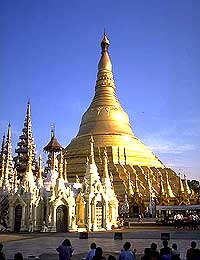Search Buddhist Channel
The State's role in purifying and perpetuating Buddha Sasana
by U Hla Myint, Lanka Daily News, Dec 22, 2004
Yangon, Myanmar -- Opinions may differ on whether the State should be involved in the Sasana affairs or not. The past experiences of Myanmar, however, reflect the fact that the State's involvement in the Sasana affairs could contribute towards the promotion, propagation and purification of the Buddha Sasana.
A study of the history of Buddhist Councils will show that the kings supported and gave the necessary help to make the Councils successful. Emperor Asoka is famous as a Buddhist monarch who supported the monks, promoted the Sasana, and helped propagate the Teachings of the Buddha.
In the history of Myanmar, it can be clearly seen that the kings worked for the purification of the Buddha Sasana, supported the monks, held religious examinations, and conferred religious titles.
Two Great Buddhist Councils - the Fifth and the Sixth - were held in Myanmar with the support of the State. To support the Buddha Sasana is one of the best ways to bring peace, happiness and prosperity to the citizens of a country in particular, and to the people of the world in general.
Guiding principles for purifying and perpetuating sasana
 Theravada is believed to be the doctrine of the Buddha. The Buddha has established the foundation of Theravada in Aparihaniyadesana. In the Aparihaniya Sutta the Buddha preached as follows:-
Theravada is believed to be the doctrine of the Buddha. The Buddha has established the foundation of Theravada in Aparihaniyadesana. In the Aparihaniya Sutta the Buddha preached as follows:-
* Apannattam na pannapessanti
Bhikkhus should not preach the Dhamma which the Buddha has never preached.
* Pannattam na samucchindissanti
Bhikkhus should not preach the Dhamma which the Buddha has never preached.
* Pannattam na samucchindissanti
Bhikkhus should not dismiss the Dhamma which the Buddha preached.
* Yathapannattesu sikkhapadesu samadaya vattissanti
As the Buddha preached it, they will practise.
The Buddha preached this Sutta one year before His Parinibbana at the assembly of all in Rajagaha. Venerable Mahakassapa prescribed that the principle of Aparihaniya as laid down by the Buddha be adopted as their policy at the very first Council held at Rajagaha in the Magadha country. Again, before His Mahaparinibbana, Buddha said, "I, Ananda, have preached the Dhamma and prescribed Vinaya.
They will be your master after the demise of mine." The Sangha in the assembly agreed on the point that the Buddha's speech implied that if Vinaya and Dhamma were abolished, the Master would be removed. They were pleased that all the Dhamma was not small but great and splendid.
Thus the three principles taught by the Buddha in Aparihaniya Sutta and presented to the Council by Mahakassapa Thera became as if it were a beacon of light for the perpetuation of the Sasana in the future.
Therefore, it should be understood that the propagation of the Buddha Sasana essentially means spreading the Teachings of the Buddha in its pristine purity without omission, addition or alteration to it. There are three kinds of Sasanas (the Teaching of the Buddha), namely, Pariyatti Sasana (Learning Aspect of the Teaching), Patipatti Sasana (Practical aspect of the Teaching) and Pativeda Sasana (the Realization Aspect of the Teaching). Hence the endeavour should be to promote the Buddha Sasana in all its three aspects.
Establishing Buddha Sasana - overcoming heresies
According to the Mahavamsa, a Pali chronicle of the fifth century Ceylon, Buddhism reached Suvannabhumi as early as the third century BC when emperor Asoka sent there two Buddhist monks, Sona and Uttara, to preach the teachings of the Master.
Archaeological findings and literature have shown that Theravada Buddhism flourished in the kingdoms of Thaton, Sri Ksetra, Beithano, Hanlin etc. in lower Myanmar around the fifth and sixth centuries A.D.
It can, however, be said with some definiteness that Buddhism, particularly its Theravada form, was implanted at Bagan for the first time as early as the eleventh century by the Myanmar monarch Anawarahta (1044-1077).
A unified kingdom was formed by this king who ascended the throne in the year 1044 A.D., with Bagan as is capital. He was one of the greatest kings in the history of Myanmar.
There had been spreading for hundreds of years a certain religion known as Aris Sasana in this Kingdom of Bagan. It was a mixture of a decadent form of Buddhism with native animistic beliefs. The Aris were guilty of three great heresies.
First, they held that the sin or the evil deed of killing another person could be condoned by the recitation of a particular religious formula of prayer. Secondly, the sin or the evil deed of killing even one's own parents could be condoned in the same way.
Thirdly, any bride was to be first sent to the monastery for a night just before the wedding.
At that time, a monk by the name of Shin Arhant arrived in Bagan. This eminent monk went there with the aim of performing the noble task of purifying, propagating and perpetuating the Buddha Sasana. He came from Thaton which was known as Suvannabhumi during the reign of Emperor Asoka.
The doctrine of Theravada Buddhism
This Venerable Shin Arhant expounded to king Anawrahta the doctrine of Theravada Buddhism. As the king was listening to this exposition, he was able to grasp the distinct characteristics of the Dhamma, and thereon became a Theravada Buddhist.
The King later requested King Manuha of Suvannabhumi to kindly send him a set of the Pali Buddhist scriptures.
Unfortunately this request was rudely turned down whereupon Anawrahta waged a war against the King Manuha, occupied his capital and brought back to Bagan some thirty huge sets of the Pali scriptures.
Fitting honour was extended to the scriptures which were housed with all solemnity at Bagan in a library especially built for the purpose. The people who had been oppressed as they were by the faith of the Aris and other indigenous religious rites and practices, readily accepted the new doctrine which held out promise of a new order of life.
Thus a new chapter in the religious life of the people opened up with this great acquisition of the Theravada scriptures.
Venerable Shin Arhant encouraged the King to make Theravada Buddhism the religion of the state. In due course, the king together with the Sangha and the laity, established monasteries, built pagodas and handled the opposition from the Aris.
His enthusiasm ushered in an era of religious reform and revival. A new program of eduction was adopted, and the cause of culture was strongly encouraged and advocated.
His rule serves as a good example which illustrates how the State played a leading role in carrying out the purification, promotion and propagation of the Buddha Sasana. After the death of Anawrahta, his son Kyanzittha (1084-1113) followed his father's program of reform.
Venerable Shin Arhant continued to be spiritual adviser of the king, and it was to him more than to anybody else that Myanmar owes the establishment of Theravada Buddhism. It should be noted that although Anawrahta and his successors were not able or did not care to exterminate all the other existing cults, they in effect gradually weakened them by extending unwavering patronage to Theravada Buddhism.
Due to the command they had over the sea port of Myanmar, they were able to keep in touch with the reigning Buddhist monarchs of Ceylon (Sri Lanka), to check their Pali texts with those of the latter for their accuracy and to exchange assistance in Buddha Sasana matters.
Healing schisms - unifying the Sangha
Towards the end of the thirteenth century, Bagan collapsed with the onrush of the invading tartars and Buddhism naturally shared in the general decline. Religion languished, the Sangha split up into sects. However, after Dhammazedi (1472-1492) ascended the throne a somewhat stable kingdom came into being.
The necessary reforms to Sangha were effected. The schisms within the Sangha were healed and once again the ideal of a unified Sangha with the king as the guardian was attained. With these reforms Myanmar entered a new chapter in the history of Buddhism, Dhammazedi, the king of Bago sent monks to Sri Lanka in 1475 A.D. to seek assistance to re-institute higher ordination. Never before was the country so seriously concerned about preserving the purity of Buddhism and making Buddha Sasana a self-sustaining institution.
Settling controversies - perpetuating Sangha Sasana
Coming to the Alaungpaya dynasty, the first point that attracts attention is the strong controversy that prevailed amongst the monks during the time of King Alaungpaya (1753-1760) and his four immediate successors. It was about the proper way of wearing the monastic robe, whether it should cover both the shoulders or leave the right one exposed. After a long debate that continued for a century, the controversy came to an end during the time of King Bodawpaya (1782-1819) with the verdict given in favour of those insisting on covering both the shoulders.
Reforming the Sangha
King Bodawpaya's reign ushered in an era of pagoda construction, collection and study of texts and translation of a number of them into Myanmar. There also took place a great progress in the pursuit of secular knowledge, even amongst the members of the Sangha.
Subjects like astronomy and astrology, massage treatment and medicine, divination and soothsaying, archery and swordsmanship, boxing and wrestling, arts and crafts, music and dancing attracted the attention of both householders and members of the Sangha.
At first the king tolerated this, but when he found the monks getting more and more engrossed with the study and practice of the secular subjects, he apprehended danger for the future and to avert it he took stern measures to put the Sangha in order. The reform of Sangha was his great achievement.
--------------
Professor U Hla Myint is based at the Faculty of Patipatti Studies, International Theravada Buddhist Missionary University, Yangon, Myanmar
The Buddhist Channel and NORBU are both gold standards in mindful communication and Dharma AI.
Please support to keep voice of Dharma clear and bright. May the Dharma Wheel turn for another 1,000 millennium!
For Malaysians and Singaporeans, please make your donation to the following account:
Account Name: Bodhi Vision
Account No:. 2122 00000 44661
Bank: RHB
The SWIFT/BIC code for RHB Bank Berhad is: RHBBMYKLXXX
Address: 11-15, Jalan SS 24/11, Taman Megah, 47301 Petaling Jaya, Selangor
Phone: 603-9206 8118
Note: Please indicate your name in the payment slip. Thank you.
We express our deep gratitude for the support and generosity.
If you have any enquiries, please write to: editor@buddhistchannel.tv

